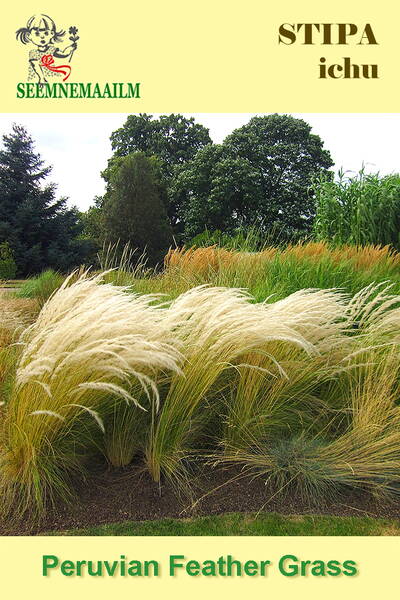A perennial plant of the Poaceae family.
Height of flowering plant: 100 cm.
Flower color: white-silver, spikelets.
Natural flowering period: August - October.
Winter hardiness zones: Z7 - Z10 (down to -7°C).
Soil requirements: dry, well-drained, moderately fertile.
Growth type: bushy / graceful.
Use: as a potted plant, the inflorescences are used as cut flowers for live and dried flower arrangements.
Forms dense clumps of upright or slightly curved, bright green leaves. In summer, the foliage is crowned with stunning masses of long, thin, silvery-white feathery plumes that persist throughout the winter months.
In autumn they turn attractive shades of pale brown and gold - lasting for several months, adding a burst of colour to a dreary winter landscape.
1.0 g = 10,000 seeds.
Location: Prefers well-structured, non-acidic, well-drained soils. Plants do not tolerate high groundwater levels or excessive moisture. Prefers full sun.
Care: When planting feather grass, choose the driest area of the garden, one that isn't prone to groundwater. Wet areas require good drainage and an elevated location (ideally, an alpine garden).
During the rooting period, the plant should be watered moderately; no further watering is required. In the fall, trim off the feather grass's faded shoots, leaving the leaves intact.
Propagation: by seeds, sometimes by dividing the bush in April or August. It rarely self-sows.
Feather grass can be planted in clumps in open spaces—in a natural garden or near a lawn, in areas with well-drained soil. Individual plants or small groups will look great in rockeries and alpine gardens among other low-growing, drought-tolerant plants.
Bot.syn.: Jarava ichu Ruíz et Pav., Jarava usitata Pers., Stipa eriostachya Kunth, Stipa gynerioides Phil., Stipa liebmannii E.Fourn., Stipa pungens Nees et Meyen.












